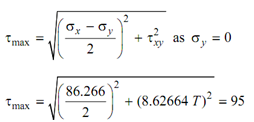Determine the magnitude of torque:
A prismatic bar of hollow circular cross-section along outer & inner diameters 100 mm and 80 mm respectively, carries a bending moment of 5 kN-m. If the compressive, tensile, and shear strengths of the material are specified as 140 N/mm2, 125 N/mm2 and 95 N/mm2 respectively, what is the magnitude of torque that might safely be applied in addition to the bending moment.
Solution
Here, the criteria to be let are as:
s1 ≤ 140 N/mm2
s2 ≥ 125 N/mm2
tmax ≥ 95 N/mm2
As the magnitudes of s1 & s2 for such bars shall be equal, we ought to satisfy only.
s2 ≥ - 125 N/mm2
tmax ≥ 95 N/mm2
I for the section = P/ 64(1004 - 804 )= 2.898 x 106 mm4
J for the section = P/32(1004 - 804 ) = 5.796 x 106 mm4
Maximum compression due to bending moment,
-( M/I ) y max = - 5 x 104 x50 / 2.898 x 106 = - 86.266 N/mm2
If T be the torque applied (in kN-m units), So,
tmax =T x 106 x 50/ 5.796 x 106 = 8.62664 T N/mm2 (under torsion alone)

43.1332 + 8.626642 T 2 = (- 81.867)2
i.e.

If the applied torque is in 8.066 kN-m, we are sure that the bar shall be safe in compression as well as tension.
Now ,we would analyse what torque shall have to be applied if tmax ≥95 N/mm2 .
We know that,

(under combined bending and torsion)

Though, we may not apply this much torque, as it shall cause compression failure. Therefore, the safe value of additional torque must be limited to 8.066 kN-m.